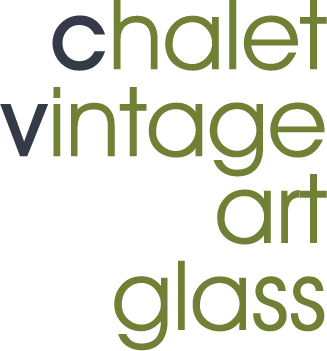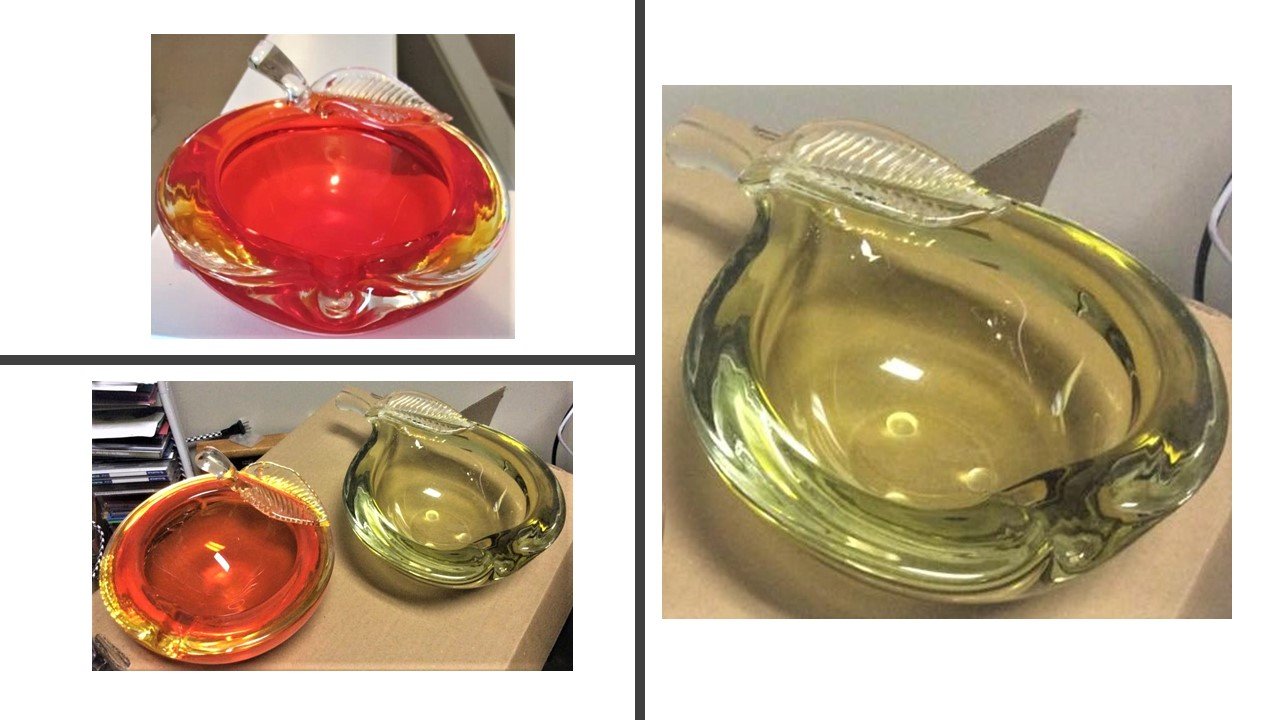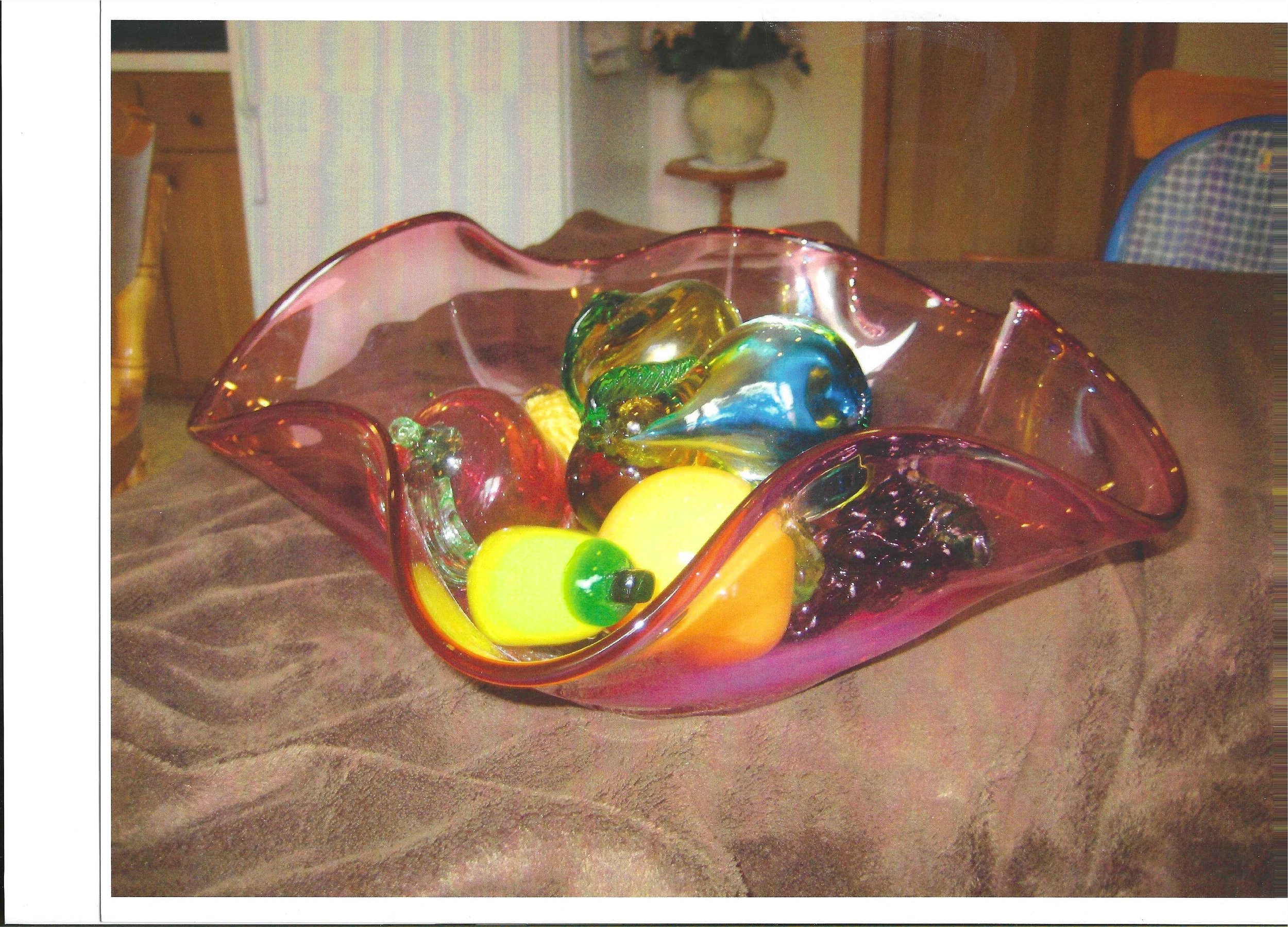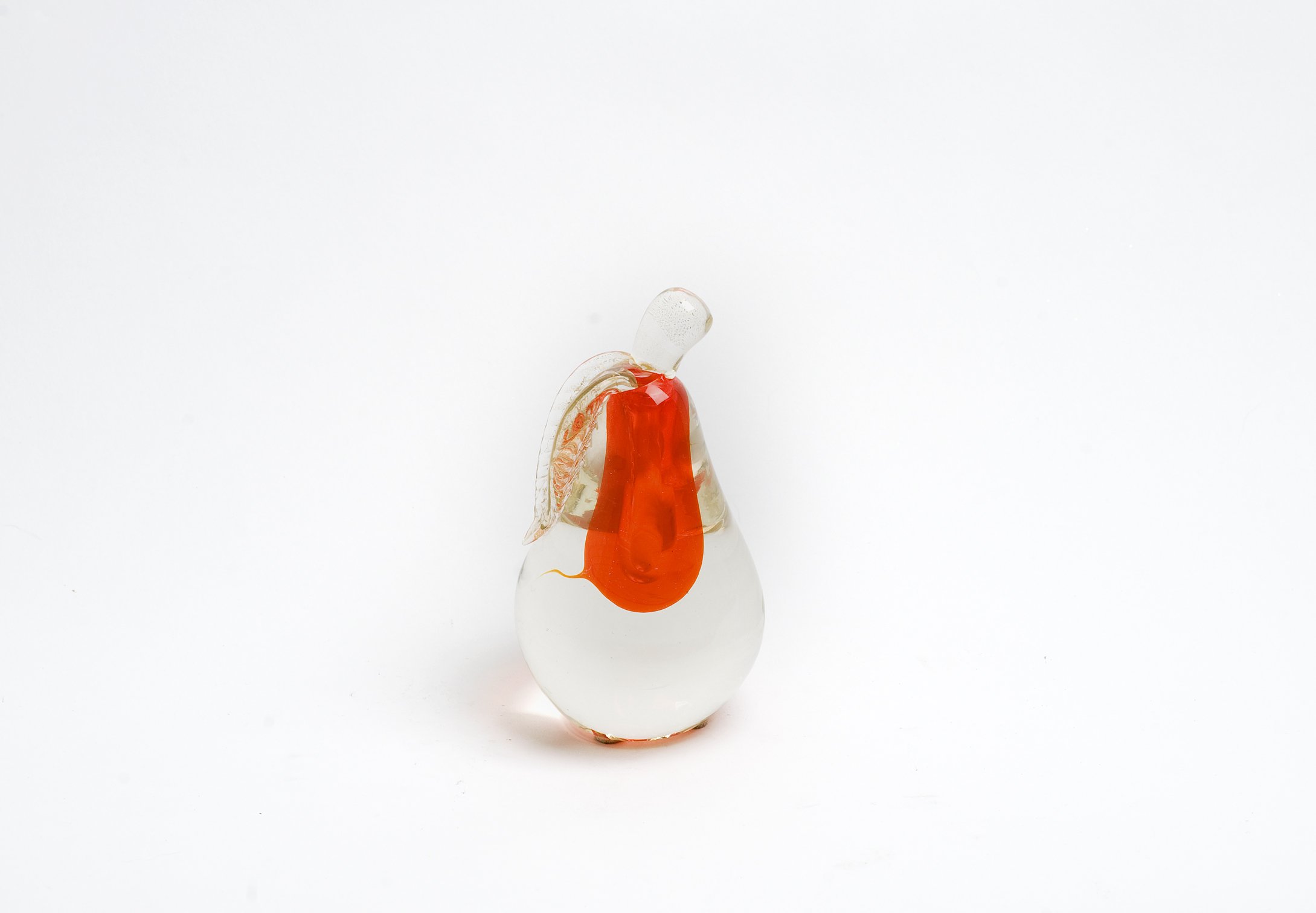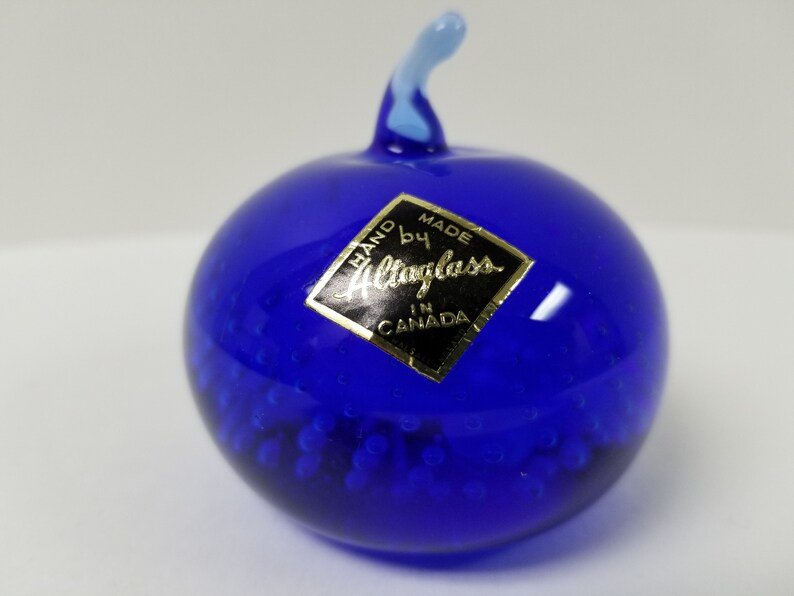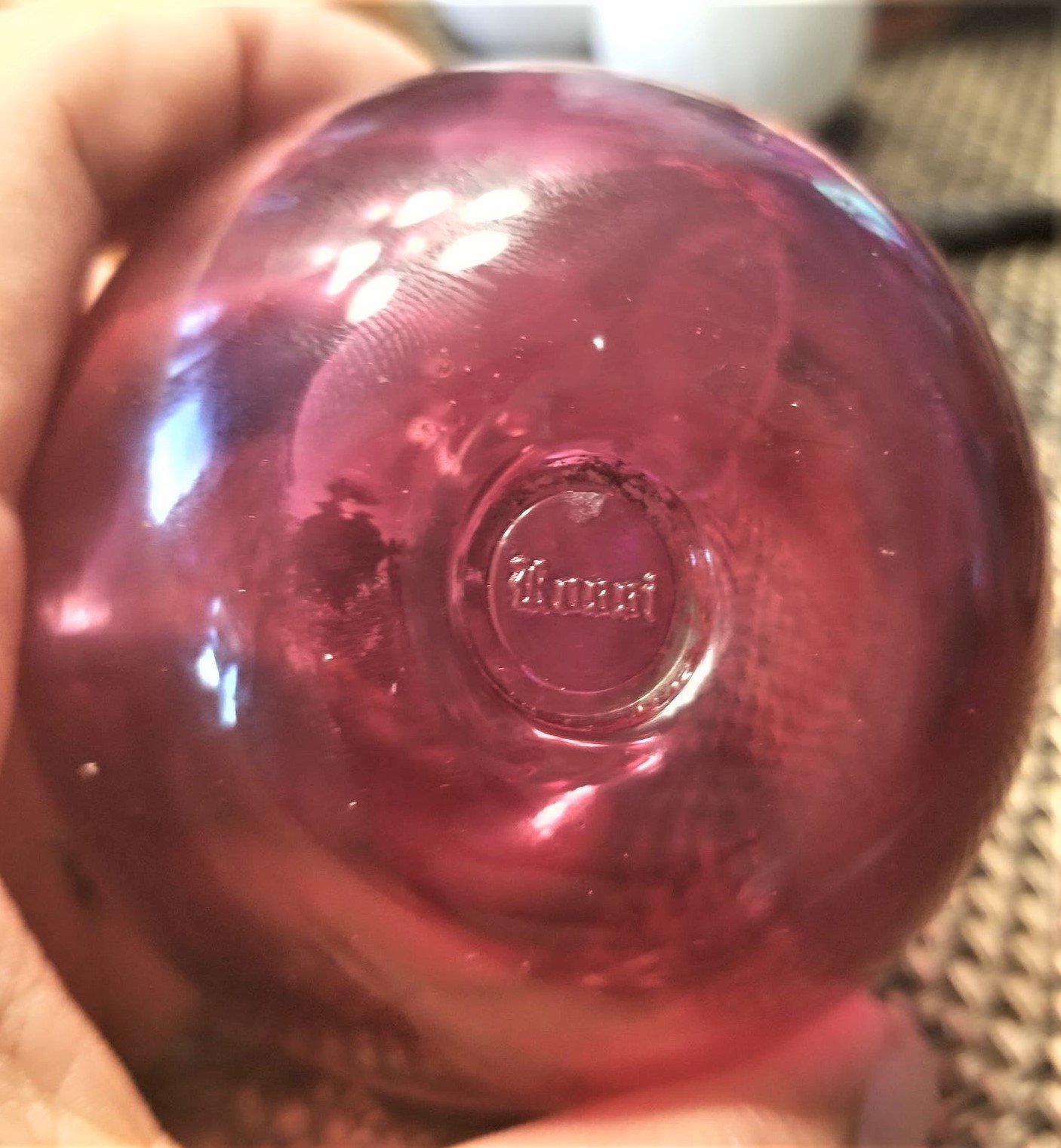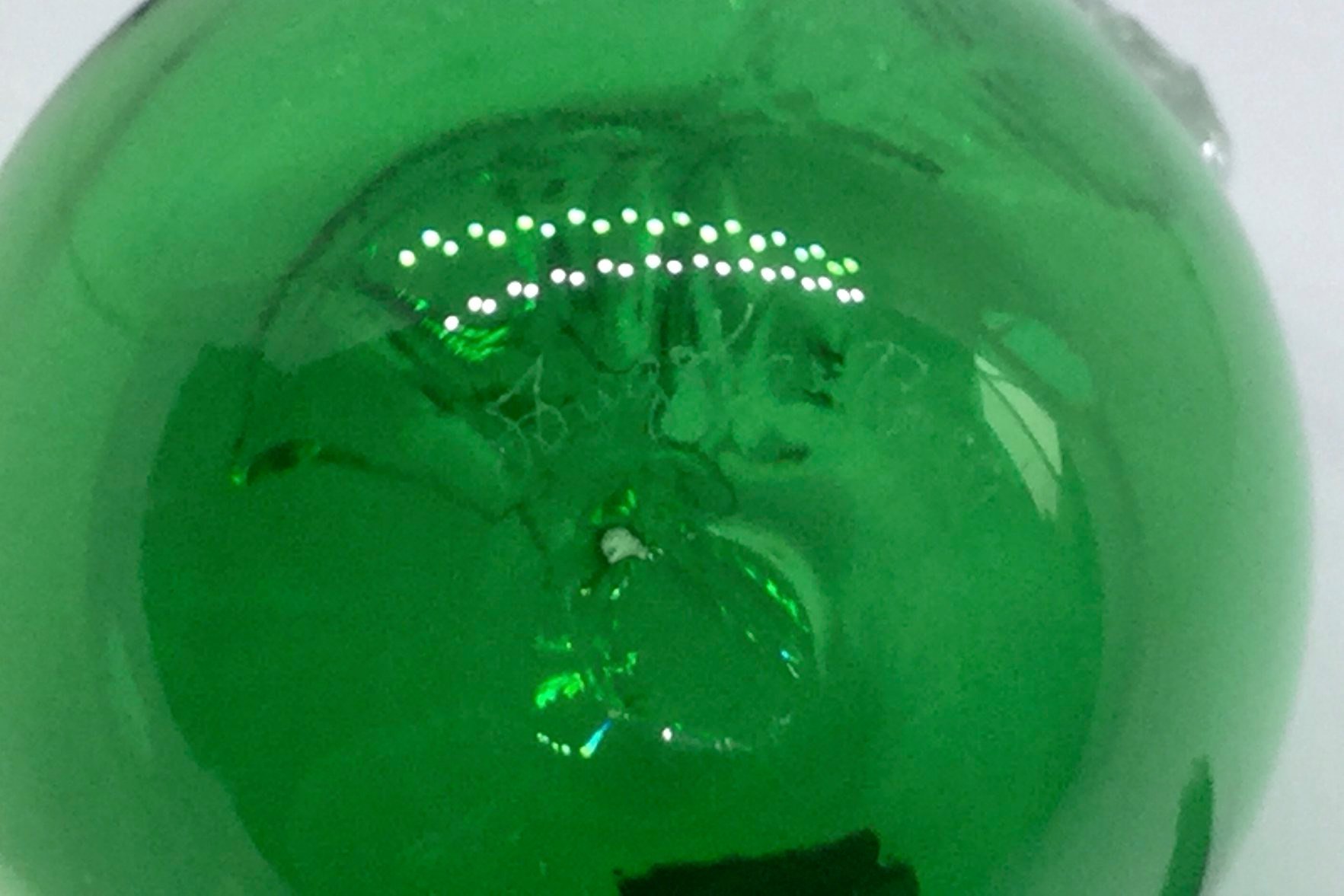Chalet Fruit Forms
The collectors’ group linked to this Web site is 50 Shades of Chalet. Each August, we celebrate the glass, the artists, and members with a week’s worth of themed “anniversary” posts. The traditional anniversary symbol for a Year Four anniversary is linen which does not relate to the glass but the modern equivalents include fruit and flowers and I can certainly do something relevant with the former! Hence this article.
Chalet and the other Canadian glasshouses did not “invent the wheel” with their glass fruit. Fruit pieces have been blown on the island of Murano for centuries. Italian forms and styles have been emulated and reproduced in countless versions world wide. Definitely fruit is iconic art glass.
Chalet did quite a few fruit forms (ashtrays, book ends, and décor pieces) in various styles. The most often seen are pear and apples. Some types of Chalet fruit were mouth blown while others were started in molds and then finished by hand. All, with the exception of the mouth blown cranberry apples with clear stems, are rare. Lorraine Glass Industries, Altaglass and Rossi also made fruit in various shapes.
Chalet “fruit” ashtrays ranged in both size and style:
Exceedingly rare are the apple and pear shaped “hand held” ashtrays. Note the applied crystal stem and leaf.
Photograph courtesy of 50 Shades member Cindy Bishop Loughlin.
This picture (courtesy of 50 Shades member Gionny Gueli who is lucky enough to now have this set in his collection) clearly shows the “butt rest” at the rear of each piece. Pear is on left in both photographs and apple is on the right. These were tiny pieces as hand held ashtrays were meant to rest in a smoker’s palm as the person moved about at work, parties, or conferences. Dimensions: pear 5” x 3” x 2” and apple 4” x 3”x 2”.
The hand-held pears have also been found in shades of green.
I do not really understand the piece shown immediately below. It was definitely a hand molded ashtray – see clear mold marks on its base and butt rest. However, it is quite a bit larger than the ones shown above. Typically, Chalet ashtrays that are stationary are never started in molds.
From the collection of 50 Shades member Jo Highland.
Larger ashtrays/cigar bowls that are also apple and pear shaped with an applied crystal stem and leaf were also produced. The leaf in these versions is gold infused with gold leaf and these bigger pieces were completely hand blown. They were not started in molds. As they are quite heavy, this style was meant to be kept stationary.
The pear shaped is very rare. Only a few have been discovered. Found in shades of green, amber, orange and blue.
From the collection of 50 Shades member Cindy Bishop Laughlin.
These were typically etched with the “Chalet Canada” signature.
The apple shaped is more commonly found.
Green ashtray from the collection of 50 Shades member Daniel Lynch. Blue from the collection of Deborah Patterson. Blues and greens in this style vary in shades. It was also made in red, orange and in differing tones of amber and gold.
This very special 4-piece set (top photo) below was shown at the 2010 Cornwall Chalet exhibit (bottom ) photo. From the personal collection of Chalet artist Antonio Tedesco.
Note that the apple ashtrays are on the riser (left background) and in the right foreground. The upright pieces (left front) and right background) that look like glasses were “ciggie holders” so that you always had “smokes” readily on hand for company. No need to fumble for a crumpled package in your purse or shirt pocket with them out on the coffee table! Times were certainly different in the 60’s.
Chalet apple and pear bookends were mouth blown and done in a set of 2 pieces – inventory #540. To date, only an apple and pear design can be verified as production pieces. They appear to have been produced in the full range of the Chalet colour palette. Bookends are extremely rare and highly collectible. The book end design is almost identical to the large apple and pear decor singles and sets (presented later on below) with the difference being that the book ends have straight cut side spots so that they are able to rest flat against and support the books placed between them. They have an applied crystal leaf and stem. The leaf has gold inclusions.
In pieces of Chalet with silver foil or gold leaf inclusions, small ultra-thin sheets of these metals were used. These silver or gold sheets were made by the precious metals having been beaten into an extremely thin leaf-like state of about 0.15 micron in width. To give you an idea of such a thin surface, this reflects about 20 grams of the precious metal covering six square meters. The sheets were then cut into small squares of about 8 cm. To infuse this gold or silver into the form, the Maestro started by rolling these small 24K gold or .925 silver sheets onto the hot glass mass during the early stage of glass-blowing. Once the gold leaf or silver foil covered most of the gather, he added a layer of clear crystal. Then, when he began to blow the glass, the metal sheet within the layers broke into smaller pieces which dispersed throughout the piece. This resulted into objects having scattered metallic pieces if differing sizes and shapes captured inside the form producing shimmering effects. These may appear close to the surface or submerged within deeper layers of clear crystal. There is no uniformity from piece to piece.
Some Chalet book end sets.
Most typically etched with the ‘Chalet Canada’ signature. However, other brandings have been found as well. as well.
This set is not only etched “Chalet Canada” but bears the remnants of the large black Chalet sticker. From the collection of 50 Shades member Pina Pina.
This is a book end set of 2 pears. However, this set was not a production item but done as a special factory one-of-a-kind order at the original owner’s specific request. She lived in Cornwall and did not like apples.
I am fortunate to now have them in my personal collection. Both are etched “Chalet Canada.”
Chalet artist Roberto De Marchi was able to give me some details regarding the Chalet fruit décor pieces:
: they were all mouth blown
: they were made by a single artist not worked by a team as were so many other pieces
:160 of the small blown apples could be produced by an artist during his shift
:Chalet made only cranberry apples. These could either have an applied clear crystal leaf and stem or green coloured ones. The cranberry pears so often seen are made by Rossi.
The one Chalet production/inventory sheet that I have which shows the fruit designates them all with the same number – the clear and cranberry apples, banana, clear or a ghiaccio lemons, and orange were all #544.
The images on the Chalet sheet are not very clear but are supplemented by this photograph captured from the 1971 National Film Board film “Here is Canada.” In this bowl, we see the listed fruit as well as some that are not listed and for which we have no other information. Specifically, a pear in the middle and a form at the top left at the 11:00 position. The composition and clarity of this photo make it hard to pinpoint details but it does add some to our knowledge.
The ubiquitous cranberry apple with the applied clear crystal leaf and stem is the most commonly found Chalet fruit form. I spoke to quite a few teachers during the 2010 Cornwall exhibit and they all chuckled about how many of these they had received over the years as teachers’ gifts.
The most common branding was the small gold foil “Chalet Lead Crystal’ sticker. However, few found retain their original labels. They can be very hard to distinguish from the Rossi made cranberry apples (shown later).
The cranberry apples were also done in variations with different textures and stem/leaf colours – these others are quite a bit more scare. The two rarer cranberry apples have a green applied leaf and stem. One has a smooth finish (in photograph immediately following) and the second has a textured surface and was designed to lay on its side.
A rare version of the common Chalet cranberry apple.
Smooth surface, flat base and with green leaf and stem. From the collection of 50 Shades member Jo Highland.
The second has a textured surface, no flat base (see circled in bowl photograph) and with green leaf and stem
Very rare. Textured surface, green stem and leaf. Also from the collection of 50 Shades member Jo Highland.
See circled image for position in bowl. As above, this photograph captured from the 1971 National Film Board film “Here is Canada.”
Clear mouthblown apples are also occasionally found:
Chalet also produced lemons in two varieties. A coloured one with the a ghiaccio (crackled) finish and a smooth clear. They are not common but we have come across a few.
Given to me by Chalet Maestro Giulio Gatto – a treasured piece. Note that the tip of the leaf is missing. As this piece has no flat base, it rolls unless secured. I do not imagine many survived intact.
The Chalet banana.
Also given to me by Maestro Gatto. It is a lovely, heavy little piece
The Chalet orange is a form that, to date, I have never personally seen nor heard of one being found. The only photograph we have:
See circled image. From it, we can see that the orange has a textured surface and green leaf. The base, or lack of, is unclear. As above, this photograph captured from the 1971 National Film Board film “Here is Canada.”
We have photographs of a few Chalet fruit that are not listed on the inventory sheet. However, I am not sure if they were production pieces and thereby shown on another page or test pieces or artists doing pieces off shift for personal possession. I am only going to offer “Never say Never.”
Such an interesting piece. We have seen a few vases with this “threading” around the throat. From the collection of 50 Shades member Kevin Hall.
This cranberry Chalet pineapple stands six inches. It belongs to 50 Shades member and Cornwall native Raymond Caron. He was told it was a “test piece.’ To date, it is the only one in cranberry that I have seen.
In 2010, I did see one in clear as well as some other surprises.
This bowl of clear textured fruit was in the collection of Chalet artist Antonio Tedesco.
Pineapple to the right of bowl in midground. Please note that the bowl in the background was made at Chalet by Antonio’s brother Chalet Maestro and owner Luigi Tedesco and engraved by Chalet owner Angelo Tedesco (another brother) who was a master engraver. And also note the unusual banana, pear, apple, and lemon in this grouping.
This is a closeup of the bowl of fruit shown earlier in the photographs above at the 2010 Chalet exhibition. You can see an apple with green leaf and stem as shown above as well as some other non=production pieces.
2010, Cornwall. On the dining table of Chalet artist Antonio Tedesco.
The larger, heavier mouthblown apple and pears are the Chalet fruit most coveted. Their design closely resembles the book end forms but without a flat edged side. They have an orb of colour that varies in size and shape and an applied leaf and stem. The leaf is avventurina. A la Gloria Swanson: “Alright, I’m ready for my closeup Mr. DeMille.”
They were sold both in sets and as singles. They are seen with quite a variety of markings and in the full range of the Chalet production colour palette – and then some! Just a few sets in the more typical colours commonly found.
I am fortunate enough to have the blue set in my collection. Not only is the apple stickered and the pear retains a rare hang tag, but both are also etched “Chalet Canada.”
From the collection of 50 Shades member Daniel Lynch.
From the collection of 50 Shades member Lori Hazuka Morin.
The orange apple and pear are bookends (#540) while the blue apple is the #544 fruit piece. From the collection of 50 Shades member Bob Burgess.
An example of the “ and then some!” A rare colour.
Rare cranberry. Pictures courtesy of 50 Shades member Lise Legare Kowalchuk.
Other Canadian glasshouses also produced decorative fruit and other forms using a fruit design.
Altaglass: An Altaglass catalogue page from the book “Altaglass: A Guide for Collectors” by Mary Coward, 1999. Page 21 is courtesy of 50 Shades member Brad McGillvray.
Altaglass produced apples and pears in a variety of colours as well as clear. Most were bullicante. They also made a pumpkin form with a textured surface which is quite rare.
These are also found in cobalt blue and a bright green.
The very rare pumpkin form. Note the textured surface.
Base. Photographs courtesy of 50 Shades member Jude Ann Olafson.
Lorraine Glass Industries: We have extremely limited knowledge regarding Lorraine fruit forms. In fact, to date, we have only one verified example.
Photograph courtesy of 50 Shades member Bob Burgess.
This 2-tone apple is suspected to be a Lorraine piece but there is no positive proof of identification as of yet.
Photograph courtesy of 50 Shades member Alex Wicks.
Rossi was a prolific producer of décor fruit as well as using the motif in other forms. These are found with branding both from one of his earlier Cornwall shops (Rossi Artistic Glass) and then with the later branding from Niagara Falls (Rossi Glass).
The two most important points to be made here regarding identification confusion are:
: First, Rossi cranberry applies are almost identical to Chalet apples. However, his are often signed or impressed so that does help. Maestro Rossi used a wide variety of labels, hang tags, engraved signatures and impressed stampings to mark and brand his glass.
Early Rossi apple on left. Chalet apple on right. While size of both varies from piece to piece, Rossi apples tend to be broader.
: Second, Chalet DID NOT produce cranberry pears. The Canadian art glass cranberry pears that are found are Rossi made.
As shown in the Rossi Artistic Glass 1988 catalogue. Courtesy of 50 Shades member Don Smith, curator Cornwall Community Museum.
Rossi cranberry apples are the most common.
This early design Rossi apple retains its original sticker from the Rossi Cornwall factory.
This particular apple, again of the early design, bears one of the Rossi stamped base impressions. From the collection of 50 Shades member Paolo De Marchi. This apple was made by his father, artist Roberto De Marchi. Mr. De Marchi also worked at Chalet Artistic Glass before the company’s closure. After Chalet’s bankruptcy, quite a few of the Chalet artists worked for Rossi.
This is a later made Rossi apple from Niagara Falls. Note the evolution in design shape (more elongated) from the cranberry apples (Cornwall factory) shown above. I think the later design resembles a “Delicious” apple while the earlier form relates more closely to a “MacIntosh” apple.
Some colours seen less frequently.
This rare green apple from the collection of 50 Shades member Dawn Tolhurst bears the engraved Angelo Rossi signature.
And another. And yet another marking.
A very rare yellow Rossi apple. Note the stamping is just the initial “R” as opposed to the full “Rossi” impression in gothic script shown above on the base of the apple made by Chalet artist Roberto De Marchi.
Rossi pears were typically done in cranberry, cobalt and yellow. They could be transparent or “frosted.” They also had an applied crystal leaf and stem.
Left is later design – Niagara Falls. Right is early design – Cornwall.
Scarcer “frosted” Rossi pears.
Another style of pear – heavier and larger. Much rarer.
A pear made by artist Roberto De Marchi while working at Rossi Glass. Still in possession of the De Marchi family.
The Cornwall factory also made glass bananas. While we have not found any stickered pieces, they are shown in this 1982 photograph from the factory retail outlet. Also in the display are apples and pears.
Photograph courtesy of the Cornwall Community Museum.
After Rossi established his glassblowing in Niagara Falls upon his second return to Canada in 1996, cranberry strawberries with an applied clear crystal hull were also produced.
The Rossi décor fruit strawberry.
Strawberry candleholders were offered as well.
To date, there have been no obvious Rossi fruit ashtrays/cigar bowls found. However, there are these two rather curious forms. The first is a candleholder. Although there are no “butt rests” on its rim, perhaps the bowl was intended as an ashtray.
Photograph courtesy of the Cornwall Community Museum.
Although these two pieces are the same form, everything else is different. The most obvious – one is cranberry while the other is a very atypical swirl of coloured glass. Branding is different. And lastly, the applied leaf and stem of the cranberry is not gold filled while the yellow dish does have an avventurina stem and leaf.
A single fruit form, a 2 tone amber and green pear, is shown on an EDAG catalog page. To date, I am not aware of any Mosaic Artistic Glass fruit forms.
